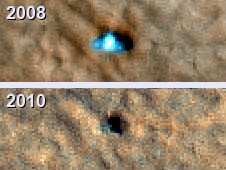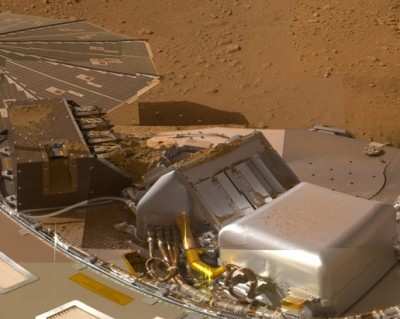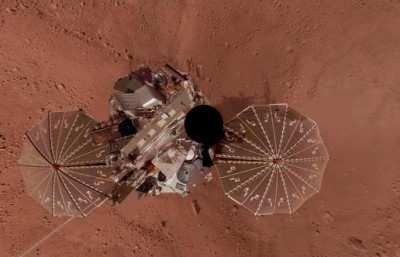Phoenix Mars Lander Does Not Phone Home, New Image Shows
Damage
 NASA's Phoenix Mars Lander has ended operations after repeated
attempts to contact the spacecraft were unsuccessful. A new image
transmitted by NASA's Mars Reconnaissance Orbiter (MRO) shows signs
of severe ice damage to the lander's solar panels.
NASA's Phoenix Mars Lander has ended operations after repeated
attempts to contact the spacecraft were unsuccessful. A new image
transmitted by NASA's Mars Reconnaissance Orbiter (MRO) shows signs
of severe ice damage to the lander's solar panels.
"The Phoenix spacecraft succeeded in its investigations and
exceeded its planned lifetime," said Fuk Li, manager of the Mars
Exploration Program at NASA's Jet Propulsion Laboratory in
Pasadena, CA. "Although its work is finished, analysis of
information from Phoenix's science activities will continue for
some time to come."
Last week, NASA's Mars Odyssey orbiter flew over the Phoenix
landing site 61 times during a final attempt to communicate with
the lander. No transmission from the lander was detected. Phoenix
also did not communicate during 150 flights in three earlier
listening campaigns this year. Earth-based research continues on
discoveries Phoenix made during summer conditions at the
far-northern site where it landed May 25, 2008. The solar-powered
lander completed its three-month mission and kept working until
sunlight waned two months later.

NASA Image
Phoenix was not designed to survive the dark, cold, icy winter.
However, the slim possibility Phoenix survived could not be
eliminated without listening for the lander after abundant sunshine
returned. The MRO image of Phoenix taken this month by the High
Resolution Imaging Science Experiment, or HiRISE, camera on board
the spacecraft suggests the lander no longer casts shadows the way
it did during its working lifetime. "Before and after images are
dramatically different," said Michael Mellon of the University of
Colorado in Boulder, a science team member for both Phoenix and
HiRISE. "The lander looks smaller, and only a portion of the
difference can be explained by accumulation of dust on the lander,
which makes its surfaces less distinguishable from surrounding
ground."
Apparent changes in the shadows cast by the lander are
consistent with predictions of how Phoenix could be damaged by
harsh winter conditions. It was anticipated that the weight of a
carbon-dioxide ice buildup could bend or break the lander's solar
panels. Mellon calculated hundreds of pounds of ice probably coated
the lander in mid-winter.

NASA Mosaic Image
During its mission, Phoenix confirmed and examined patches of
the widespread deposits of underground water ice detected by
Odyssey and identified a mineral called calcium carbonate that
suggested occasional presence of thawed water. The lander also
found soil chemistry with significant implications for life and
observed falling snow. The mission's biggest surprise was the
discovery of perchlorate, an oxidizing chemical on Earth that is
food for some microbes and poisonous to other forms of life. "We
found that the soil above the ice can act like a sponge, with
perchlorate scavenging water from the atmosphere and holding on to
it," said Peter Smith, Phoenix principal investigator at the
University of Arizona in Tucson. "You can have a thin film layer of
water capable of being a habitable environment. A micro-world at
the scale of grains of soil -- that's where the action is."

Pheonix Self-Portrait Vertical Projection NASA
Image
The perchlorate results are shaping subsequent astrobiology
research, as scientists investigate the implications of its
antifreeze properties and potential use as an energy source by
microbes. Discovery of the ice in the uppermost soil by Odyssey
pointed the way for Phoenix. More recently, the MRO detected
numerous ice deposits in middle latitudes at greater depth using
radar and exposed on the surface by fresh impact craters. "Ice-rich
environments are an even bigger part of the planet than we
thought," Smith said. "Somewhere in that vast region there are
going to be places that are more habitable than others."
 NTSB Final Report: Rutan Long-EZ
NTSB Final Report: Rutan Long-EZ ANN FAQ: Turn On Post Notifications
ANN FAQ: Turn On Post Notifications Classic Aero-TV: ICAS Perspectives - Advice for New Air Show Performers
Classic Aero-TV: ICAS Perspectives - Advice for New Air Show Performers ANN's Daily Aero-Linx (06.28.25)
ANN's Daily Aero-Linx (06.28.25) Aero-News: Quote of the Day (06.28.25)
Aero-News: Quote of the Day (06.28.25)






